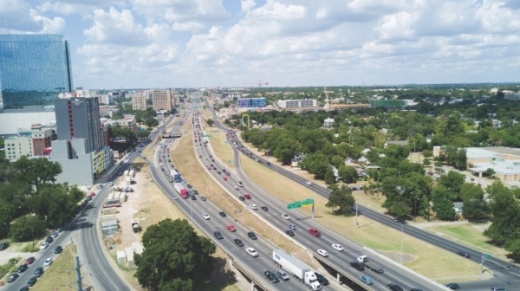On Feb. 27, the Texas Transportation Commission authorized a plan to allocate $4.3 billion to fill the funding gap needed to kickstart what the state calls the Capital Express Central project—which would add two nontolled managed lanes, or carpool lanes, through downtown Austin from US 290 East to SH 71.
The commission would allocate the funds by updating the Texas Department of Transportation’s Unified Transportation Program. The UTP is “neither a budget nor a guarantee that projects will or can be built,” according to TxDOT’s website, but it is a planning tool that signals the projects TxDOT expects to take on in the next 10 years and identifies funding.
Brian Barth, TxDOT’s director of project planning and development, told the commission it could officially add the I-35 central project to the UTP April 30 after a public hearing period. Barth said construction could start in 2025, and the estimated length of the project is expected to be about four years.
The Central Austin work is part of a larger $7.5 billion project to upgrade I-35 through Williamson, Travis and Hays counties. Work on the north and south sections of that project, expected to cost about $700 million, is scheduled to start in 2022. The project is the first major overhaul for I-35 since 1974, when Texas Transportation Commission Chair J. Bruce Bugg noted Austin had a population of 297,000.
“Any further delay in funding improvements to I-35 is simply unacceptable,” Bugg said.
Where the money comes from
To fill the $4.3 billion gap, the Texas Transportation Commission will have to make three different funding decisions. The commission updates its UTP—the 10-year plan for projects—every year. It would allocate $3.4 billion in the plan scheduled for approval in August of this year and $300 million in the 2021 plan.
The final piece—$600 million—would come from TxDOT money that has already been been allocated to the Capital Area Metropolitan Planning Organization, which is responsible for planning projects in the six-county Central Texas region. Bugg said CAMPO had allocated that $600 million on projects “that are just not moving forward.”
TxDOT’s funds come from four main sources, Bugg said. Traditionally the money has come from federal gas tax and state highway gas tax revenue. In 2014 and 2015, Texas voters expanded TxDOT’s sources of revenue in what is now known as Proposition 1 and Proposition 7 funds—allowing the state to expand transportation funding to include sources such as oil and natural gas production taxes, sales taxes and vehicle rental taxes.
The addition of Proposition 1 and Proposition 7 funds expanded TxDOT’s budget 44% to $77 billion for this UTP, freeing up the funding for I-35, Bugg said.
“Those two funding streams allowed us to think big and bold,” Bugg said.
Toll roads in the conversation
In a statement provided to the commission, state Sen. Kirk Watson, D-Austin, called the billions of dollars on their way into the I-35 project “long overdue, but greatly appreciated” and called the project “a multi-generational commitment.”
After offering gratitude for the project getting off the ground, Watson did, however, offer a mild criticism.
“I don’t think this financing mechanism is perfect. It’s not, in my view, the best way to meet our mobility needs locally and the financing needs of our state,” he said in a statement.
In August, when the commission approved its 2020 UTP, Watson encouraged the commission not to move forward in a way that would make tolled roads an impossibility. In 2017, Texas Gov. Greg Abbott and Lt. Gov. Dan Patrick said they would not support any Proposition 1 or Proposition 7 funds going toward tolled projects.
“I understand very little, but I do understand politics every now and then. I understand the political environment I speak to you in. But that political environment may not always be there,” Watson told the commission in August.
Dewitt Peart, president and CEO of the Downtown Austin Alliance, said the commission’s decision Feb. 27 to go with managed nontolled lanes does not necessarily prohibit tolls at some point in the future. Peart said more than the question of tolled or nontolled, the managed lanes will be key to moving people through Central Austin.
“We can manage what traffic goes on there, and ideally the support for those managed lanes drives directly to using the lanes for transit,” Peart said.
Bugg said TxDOT is currently operating in a “nontolled environment,” and the plan approved Feb. 27 adheres to that policy.
“There are some people that believe there should be other financing mechanisms, but state policy does not allow that to happen. So what I'm doing as chairman, is I'm working with the tools that I have,” he said.
Design and safety questions
The commission made no design or engineering decisions on Feb. 27—it only allocated the funding for the project and said it would add two managed lanes, one auxiliary lane and one frontage road lane in each direction.
Luke Ellis is one Austin resident keeping an eye on the project as it advances through later stages. Ellis, an adjunct professor at the University of Texas School of Law and attorney with firm Marrs, Ellis and Hodge, represents landowners disputing eminent domain claims when their property is taken by a government or other agency. Ellis said the agencies his firm enters the most disputes with are the state of Texas and TxDOT.
On Feb. 27, Bugg said TxDOT is committed to go “no wider and no higher” to avoid disruptions to local businesses, but final engineering decisions will come at a later stage of the process. Ellis said while the I-35 project is crucial, business owners need to be treated fairly.
“I’m cautioning as a community we be sure we treat the property owners who are going to be directly negatively impacted by the expansion fairly.”
In November, TxDOT’s My35 program manager, Susan Fraser, said the state agency is considering a variety of possibilities, including taking down the upper decks and between Martin Luther King Boulevard and Airport Boulevard and putting lanes underground through a portion of the city.
Jay Blazek Crossley is the executive director of nonprofit Farm and City, which leads the Vision Zero Texas effort to end traffic deaths. He thanked the commission for dedicating resources to the project and said the design will be crucial in determining the project’s success.
“It is crucial you upgrade these facilities to modern, safe design standards as soon as possible. Modern, safe design standards means not designing for people driving fast in the middle of our cities. There’s no point, and it’s killing people,” Blazek Crossley said.





